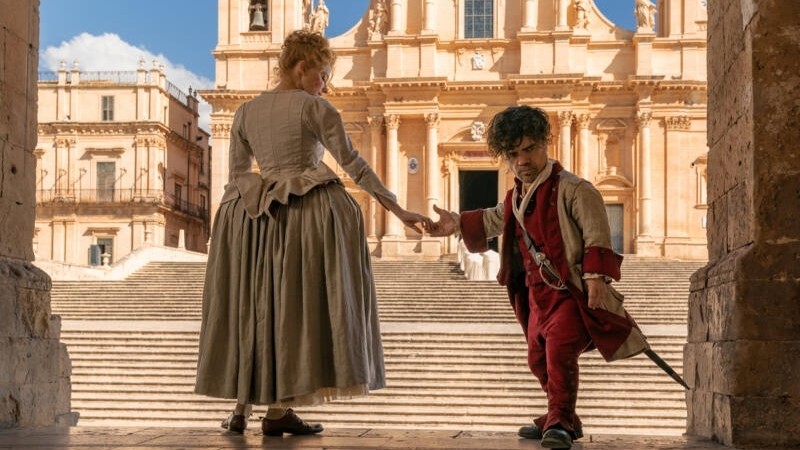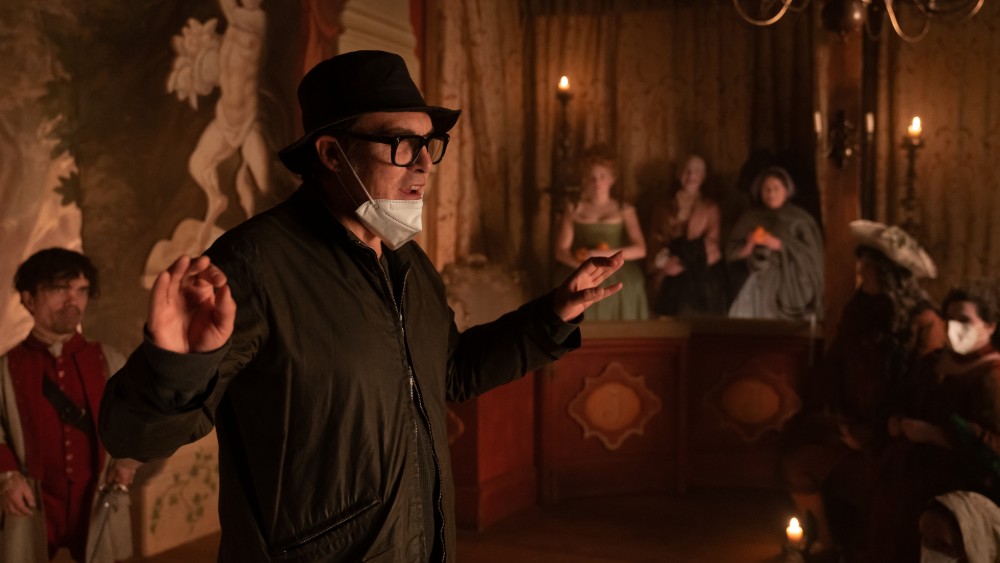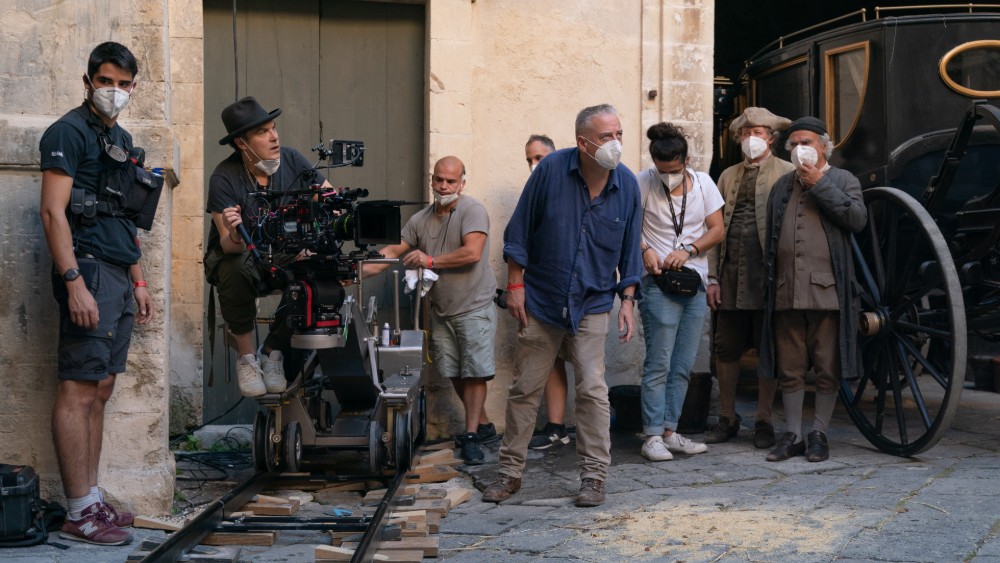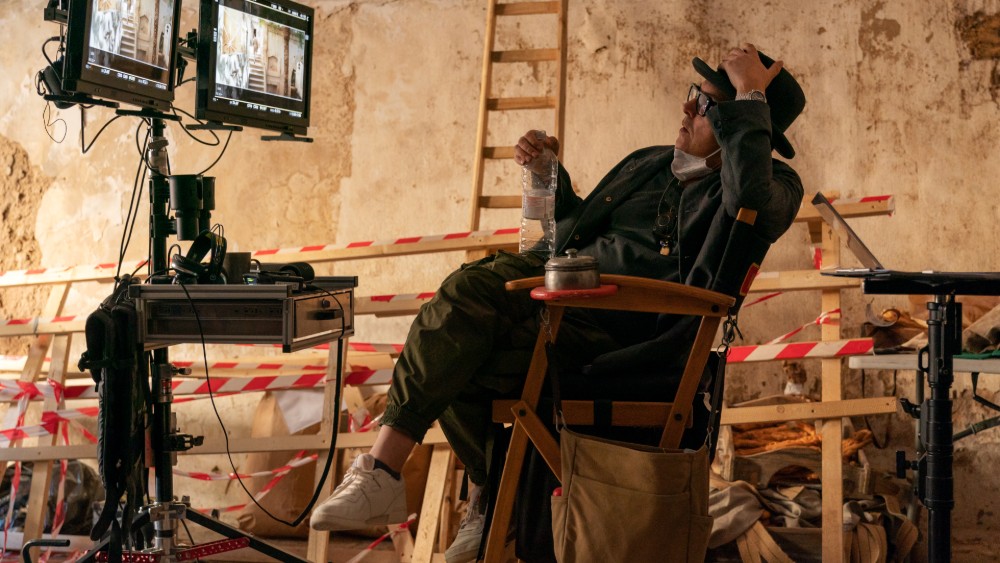
Over the course of his 25-year career, British filmmaker Joe Wright has directed two movies to Best Picture nominations and three actors to Oscar-nominated performances — including Gary Oldman‘s only Oscar win for Darkest Hour — but Cyrano might be one of Wright’s best films to date. It’s also the director’s first full-on movie musical, as it uses the music from rock band The National to tell the classic tale of wordsmith Cyrano de Bergerac, whose life, as fictionalized by Edmond Rostand in the 19th Century, has become the source of inspiration for numerous plays and films over the years.
This time, Game of Thrones alum Peter Dinklage stars as Cyrano, who is infatuated with his childhood friend Roxanne (Haley Bennett). Although he can easily craft the words to woo her, he doesn’t feel she could ever love him due to his short stature. Enter Kelvin Harrison Jr.’s dashing Christian, who Cyrano thinks he can manipulate to get Roxanne’s attention, although she’s also being wooed by the nefarious Duke, as played by Ben Mendelsohn, who will have Roxanne at any cost.
Wright’s talented ensemble is tasked with singing the words of National frontman Matt Berninger and his wife Carin Besser, backed by the music of Bryce and Aaron Dessner. Meanwhile, Dinklage’s wife, Erica Schmidt, wrote the script, which is based on her 2018 stage musical that was adapted from Rostand’s original story.
A lot of love went into Cyrano’s journey to the big screen, and as always, Wright surrounded himself with an amazing team of artisans who helped create Cyrano’s stunning look. The film sees Wright reunite with DP Seamus McGarvey, who was nominated for two Oscars for shooting Wright’s earlier films Atonement and Anna Karenina, as well as his long-time Production Designer Sarah Greenwood.
Unfortunately, their contributions were overlooked by the Academy this year, as Cyrano only received one Oscar nomination for the costumes designed by two-time Oscar nominee Massimo Cantini Parrini and Jacqueline Durran, who won her first Oscar for her work on Wright’s Anna Karenina.
Below the Line spoke with Wright back in October, shortly after Cyrano premiered at a number of fall film festivals, and though the film has had a bumpy ride to release, it will finally hit theaters this weekend. Enjoy our chat below, and be sure to check out the film’s soundtrack, which I think will prove quite popular with fans of The National.

Below the Line: When one looks at the movies you’ve made, which are quite literary between Pride & Prejudice, Anna Karenina, and even Pan, it almost seemed inevitable that you’d eventually tackle Cyrano.
Joe Wright: It’s true. I do feel like somehow it’s been a natural progression to this movie. Anna Karenina was conceived as a ballet, and it feels like a natural progression to do a movie where people actually sing and dance. It felt very natural.
BTL: I’m a pretty big fan of The National, so I was shocked when I heard they’d written original songs for a musical. Did you have a chance to see Cyrano when it was performed on stage?
Wright: Way back before it came into off-Broadway, I saw a very rough workshop production at a small local theater, the Goodspeed Theater in Connecticut. It seats 120 people, and they did a workshop run of a couple of weeks. I saw that production, which was very different from how the film ended up, but I was very taken with Pete’s performance and Haley’s performance, and the chemistry between the two of them, and so, I approached Pete and Erica and said I’d be interested in developing the show as a movie. They said ‘Well, we’re doing an off-Broadway run,’ and I said, ‘Okay, great, but let’s do these scripts in parallel,’ so that’s what we did.
BTL: Pete and Hayley really were quite amazing together in the film, so whatever you saw at that workshop is all on screen. Since this interview is for Below the Line, I do want to talk to you about the gorgeous crafts for the movie. The color palette for the film is especially striking with its reds, browns, and grays. And then whenever there’s more color, the scene really pops out, like when Haley is at that club, which looked like a Renaissance painting. Can you talk about choosing the color palette for the film?
Wright: I think I’m probably a bit of a colorist, really. I love color, and I love the meaning of color and the emotional power of color. The film has two or three actually distinct color palettes in three different parts of the movie. The first part of the film was shot in a town called Noto on the island of Sicily. The first color influences [were] the stones of the city, which are these incredible honey color. The whole town turns pink at dusk, and I remember the painter, the Italian monk, Fra Angelico, and loving his work, especially a painting he did of the Annunciation in San Marco in Florence. He has this incredible way with pink and green. I remember being stunned by this combination, seeing that painting and then walking out of San Marco and looking at the sky, and suddenly realizing that magic hour in Florence, it all goes pink and green. The sky, instead of blue, is green. So, that was the first color reference for the movie.
And then, if you look at the angel’s wings in the movie, you get these amazing cobalt blues and grays, and this golden hair, so the color palette of the first part of the film is very much based on Fra Angelico. One wanted to get across this feeling of love and first love and the passion of that, the intensity of that. So, it’s very warm, and there are some lovely deep reds in there. There’s this kind of passionate tone color palette, and then, we move to the war sequence, and everything changes. We drain all the color out of it, and it becomes very monochromatic. Not in the kind of modern blues that you see in a lot of movies. I wanted kind of a dirty black and white. The whites are almost a little bit yellow, there’s a kind of stained white to the thing, so it becomes very black and white.
And then the final sequence, I was wanting a kind of heaven, so we’re back to the honey-colored stone. The costumes are all white, and I treated it slightly differently so that it has cleaner, more beatific highlights.
BTL: You did most of that in-camera with your DP Seamus McGarvey and in concert with the production and costume designers prior to filming rather than adding color in post, right? Or was it a combination of the two?
Wright: I walk around with a book of color references. As we’re designing stuff, when we find the right… the theater set, for instance, is all red and green, and so when I find the right red and green, I’d take a reference of those colors, I keep them in my book, and then when I’m looking at costumes, I can look at the fabric that we’re thinking about against the colors of the set. I’m constantly referring the colors to each other, and all of those decisions are made in pre-production.
BTL: How many sets did you build for Cyrano and how much of the film was shot on location?
Wright: The whole movie is location-based. We built one set, which was the theater set, but we built that into a location.

BTL: I notice you work with a lot of the same crew and department heads, such as Seamus, but in different configurations from your previous movies.
Wright: Sarah Greenwood, my production designer, and Katie Spencer, my set decorator, have been working with me for the past 24 years. There’s only one film that I’ve made that they haven’t designed, which, in fact, was Pan. So I learned my lesson there. It’s a very tight collaboration between myself and Sarah and Katie, and we’ve worked together on every film. Seamus has made five of the nine films I’ve made. My sound team, my dialogue editor, for instance, Becki Ponting, has fulfilled that role on every film and television thing I’ve ever done. So yeah, it’s very much a collective, a family.
BTL: Do you find that it’s hard to keep these people from project to project? I’m sure Seamus is very much in-demand.
Wright: Yeah, I do, because they keep on getting nominated for Oscars for my films, and then, everybody else wants to work with them. I’ve got a bit of a problem with my next movie because they’re all busy, so I might have to wait for them, which is devastating.
BTL: I’m curious about the timeline for Cyrano. You mentioned there was some crossover between the off-Broadway run and doing pre-production on the movie, so when did you actually start? What was Day One for the movie?
Wright: You kind of ease into it, rather than a kind of hard start. Whilst I’m developing the script, over the course of a couple of years, I’m already talking to Sarah Greenwood. We have a wonderful visual researcher [named] Phil Clark, and Sarah and I are talking to him about finding references, historical and otherwise. A lot of those references and ideas that Sarah and I come up with together will be fed into the script. Sarah usually comes on about 16 weeks prior to shooting, but that’s a very skeleton crew at that point. Then we kind of start proper pre-production 12 weeks prior to shooting. That’s when we get offices, and that’s when money starts to be spent by the studio. And so, that’s when we feel like, ‘Okay, we’ve really got a film here.’ But you never quite believe that until you’re actually on set shooting the first day, especially not under the circumstances of a global pandemic.
BTL: That’s a great lead-in to my next question, because the pandemic is something that has affected all projects since early 2020, so were you actually shooting by then?
Wright: No, no, no. I’d been sitting on my ass in isolation for four or five months, and it was June 28, 2020 that I called [Producer] Eric Fellner up and I said, ‘Okay, I think the script is ready. Let’s do this.’ And Eric was like, ‘You’re crazy. This is never gonna happen.’ But we sort of fished around for finance, and MGM came through for us. Amazingly, I think they were the only people financing anything at the time, and so we went out to Sicily to start pre-production there on the 28th of August, and we started shooting on the 4th of October 2020, and wrapped on December 18, 2020.
BTL: Italy was hit pretty bad by COVID, so had the COVID numbers in Italy gone down significantly by the time you started filming?
Wright: Italy was hit pretty hard, but Sicily wasn’t. It’s an island off the coast of Italy, and basically, there weren’t any people coming in or out. It had locked down, and so, that was one of the reasons why we chose Sicily. Also, we could control more easily the contact with the outside world. The town where we shot, Noto, is a world heritage site and usually has a lot of tourist traffic, but none of that was happening, so the town was incredibly quiet. We created a COVID bubble of about 300 people, 350 people, crew, cast, extras. Everyone was getting tested every second day. A lot of our crew came from Rome, and we all just kind of hunkered down. It created an amazing atmosphere of creativity in the face of adversity. It was powerful.
We had a very small group of extras. When I say small, we had a maximum at anytime of 120. If you watch the film closely, you’ll possibly notice that they pop up in different costumes in different scenes. There’s one guy who actually – a bit too obviously – he pops up as a baker, then as a marquis in the theater scene, and then he’s a soldier starving at Mount Etna. Kind of rather like a theater company, we put people in different costumes and gave them different roles to play.

BTL: When I spoke to Kay Cannon for her musical Cinderella, she was telling me the same thing about having the same background actors in different roles. I’m not sure if most people would even notice if they weren’t told.
Wright: Well, you embrace it. I mean, it’s a musical, and one of the really good things about musicals… although I was trying to create a musical that had a kind of authenticity and a naturalistic atmosphere… there’s a certain license with musicals because of its inherent theatricality.
BTL: One thing that impressed me — and this was before I knew Peter had done the musical off-Broadway — is that you can tell he’s really singing, probably on set, but also doing his own sword-fighting, too, which I also thought was great.
Wright: All the singing is live. Everyone sang live, including Ben Mendelsohn. They sang live on set. I wanted to create a visceral intimacy. The film is about connection between people, or rather, the people failing to connect often, and so it was important that there was a kind of intimacy to the thing as a whole and especially for that singing. So all the songs were recorded live.
BTL: I have to ask you about working with The National. You’ve worked with many bands over the years, including the Chemical Brothers, and you come from a music background. How did the Dessners’ involvement evolve into composing the overall score, and did they put together the music for the actors to sing to as well?
Wright: I worked very closely with Bryce and Aaron and Matt and Carin. Matt and Carin wrote the lyrics, and the vocal melodies, Bryce and Aaron wrote the music and the score. They were so open. It’s really exciting to work with people whose natural or usual medium is not film, because they have no preconceived ideas and they don’t have bad habits, and they don’t have any way of, you know, ‘This is how we do it.’ They come at it with completely fresh eyes or ears, and we work very closely in developing the thing.
By the time we got to shooting, we had rough demos of all the instrumental sections and backing tracks. Bryce came out to Sicily with us and worked with the actors, getting them up to scratch, and then he was around for the beginning of the shoot. The actors listened to those backing tracks in their ears, and then sang live. We also had a live pianist as well on set. If it was a song that could kind of be off-click, then he would play, and he would follow the singers, rather than the singers following the backing track.
BTL: It’s a real testament to your cast and crew that it turned out so fantastic. If you watched this movie 10 years from now, I’m not sure you’d know it was made during a full-on pandemic. I’m glad I got to see it in a screening room with a decent sound system, too.
Wright: I’m trying to make sure that everyone sees the film on the big screen with a proper sound system. In a way, there were a lot of things about the COVID situation that created opportunities. I had my Mum, who’s a puppet maker and prop maker, she made 160 leather masks that could be worn by the extras on camera to help stop the spread of any potential infection. So, that’s why there are a lot of characters walking around with those strange Commedia dell’arte masks.
Our final question involves a minor spoiler involving a musician cameo, so only continue reading if you dare…
BTL: This movie has one of my favorite cameos, possibly ever. I’m not sure how many people will realize that’s Glen Hansard from Once, but as soon as he starts singing, I knew it was him.
Wright: Do you know Sam Amidon as well? He’s a wonderful folk singer. He’s worked with the Kronos Quartet and has a wonderful recording career of his own. And then, Scott Folan, who sings with Sam and Glenn, was a newcomer, but they became very close. Actually, when they weren’t working, which was a lot of the time, because everyone would have to come out and then isolate in Sicily, and then they weren’t allowed to go home. They couldn’t come and go. There were a lot of people kind of waiting to work, so Sam and Glen and Scott started busking in the evenings. If you were lucky enough to be walking through the streets of Noto in the fall of 2020, you could very well have heard Glen Hansard busking in the streets.
Cyrano opens nationwide on Friday, Feb. 25. Click here to read our interview with composers Aaron and Bryce Dessner, and click here to read J. Don Birnam’s review of the film out of Telluride.





